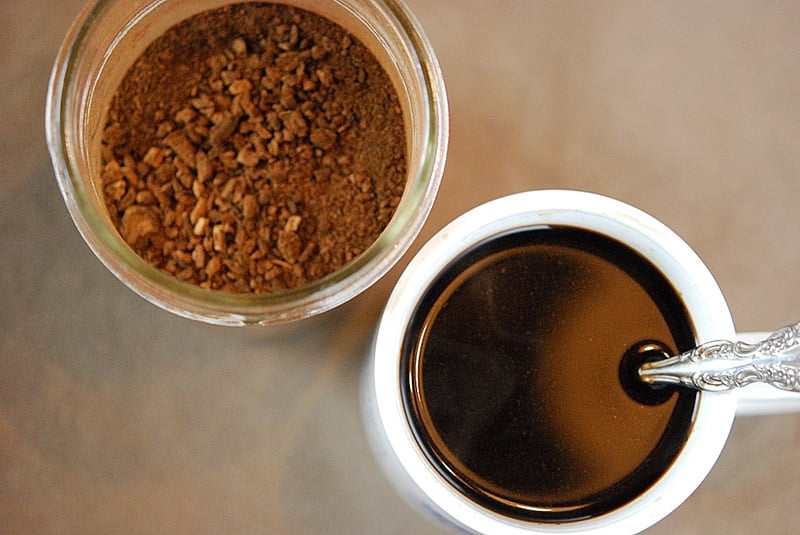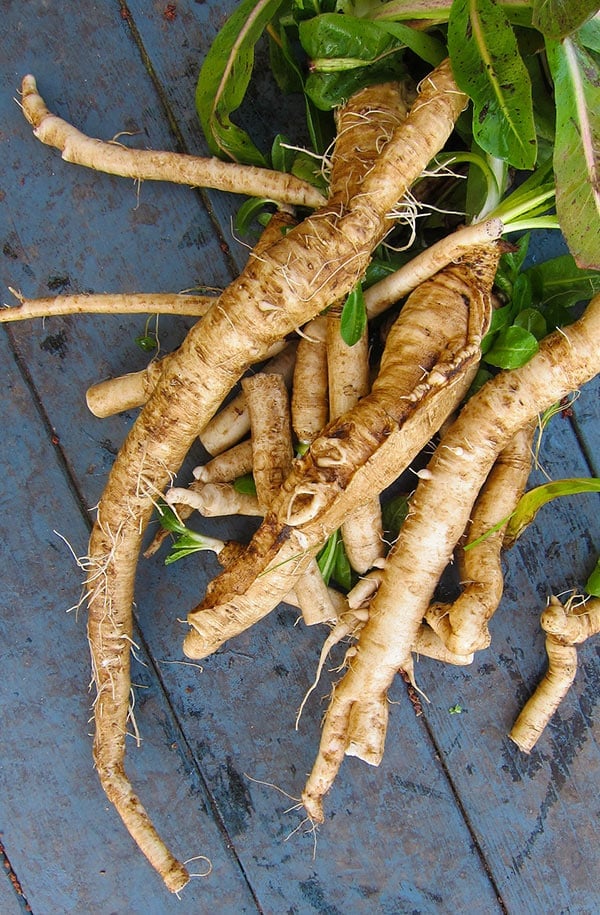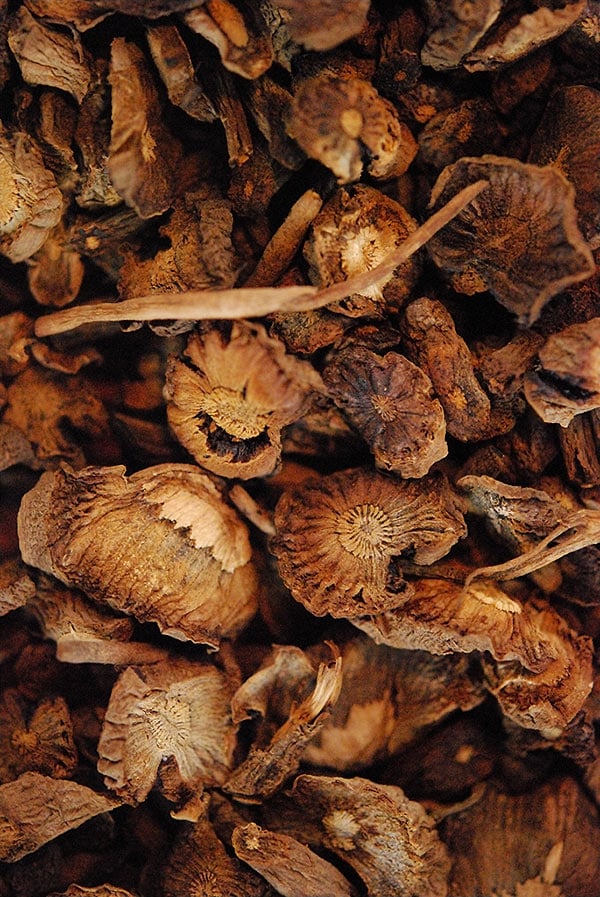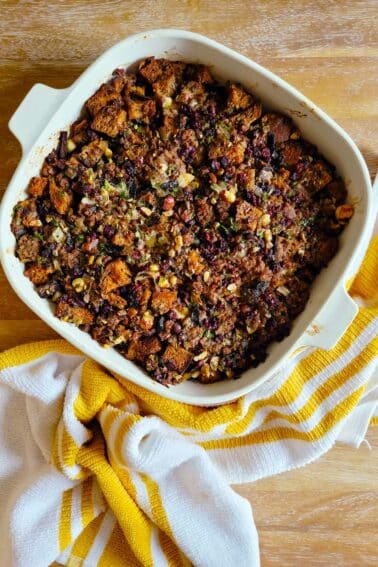As an Amazon Associate I earn from qualifying purchases.

For a time, my favorite coffee was New Orleans style, where the coffee is cut with roasted, ground chicory root. Chicory coffee is smooth, a little more acidic than normal coffee, with a taste and aroma similar to a mocha — and it makes a drink darker than the inside of a cow.
I used to Ozark it up even more by drinking it black, sweetened with molasses, not sugar. Definitely a manly drink, and probably the reason I have so much hair on my chest. I imagined lumberjacks or pioneers drinking this between cutting wood or fording wild rivers.
I was not in the habit of doing either, so I ultimately switched back to straight coffee. Actually I stopped because the canned chicory coffee I’d been buying grew pretty grim on my tastebuds over time; stale and dusty tasting. I never found anyone who made a premium version, so I left chicory coffee by the wayside.
I knew I could make my own by digging up the raggedy sailors — chicory is that weedy azure-blue flower that grows on a roadside near you. But I’d never bothered with it, as you need to dig in fall, and I only really notice this plant in summer when it’s flowering, or in early spring when I eat the greens.
But then I bought some “root chicory” seeds and planted them. Now I had absolutely no intention of making chicory coffee from them. I have a thing for crazy root vegetables, and it is my contention that if more locovores living in Northern climates grew a wider variety of roots, their winter menus would be far more interesting. I wanted to test this root out as a vegetable, so I planted it in my root bed next to the scorzonera I experimented with this year.
And then, as typically happens, life got in the way. I looked up and it was May already — while the chicory roots had not yet sent up flower stalks (except for one), they would be far too bitter and “hot” to eat as a veggie. Damn.
What to do with these things? I pulled one and was astounded at how large it was: A good 30 inches, with a base about two inches across. Christ, that’s a big root. And then I remembered my lumberjack coffee. But just how do you make chicory coffee?
I’d read a few sets of instructions that say just wash and dry the roots, then roast them in a moderate oven until “ready,” then break into pieces and grind into coffee-like grounds. I knew intuitively that this was false. I could not imagine breaking a root that was two inches broad into pieces small enough to not kill my grinder.

Other sets of instructions, mostly for making dandelion coffee (basically the same thing), call for slicing the roots into thin discs, then drying them, then roasting them, and then grinding them. This sounded more sane.
So I began slicing up the 20-or so large chicory roots I’d managed to pull. I ate a few raw, and they weren’t terrible: If something can manage to be sweet and bitter at the same time, these roots achieved that feat.
When I was doing this, it was 104°F outside. Not ideal oven drying weather, but perfect weather to dry things outside. And my “drying rack” of choice is the hood of my pickup. So I sat these sliced roots out in the sun, and they dried nicely in two days.
When it came time to roast the chicory, I found even more misleading instructions on the internet; yes, I know — misleading information on the internet?! Heavens! Everyone seems to say roast dandelion or chicory root in a 350°F oven for 10 to 15 minutes. Uh, yeah. You then have slightly warmer dried chicory roots. Nope, instead of 15 minutes, try 90 minutes, or even two hours. I might try 2 to 3 hours at a lower temperature next time.

I’d just like to say that even if you have no intention of actually drinking chicory coffee, it is worth roasting the roots this way. The whole house smelled wonderfully malty, chocolatey, warm. So lovely.
I let the roots cool overnight and ground them. Unfortunately they don’t seem to grind evenly, so I have powder mixed with chunks. But I use a press pot for my coffee, whose filter is enough to strain it all out.
I decided to brew myself a straight cup of chicory coffee. I put about a 1/4 cup into my press pot, the same amount I use for coffee, boiled some water and steeped the inky brew for about 5 to 8 minutes. I drank it black, with sugar.
Straight chicory coffee is some powerful stuff. it tastes like it is loaded with caffeine, but it isn’t. It looks a lot like motor oil, has that malty-chocolate aroma, a brighter acidity than coffee and a flavor I really am having trouble describing as other than with the cliche “earthy.” Guess that’s what I get for roasting a root.




best post on roasting chicory I have found yet. As you noted, there are a lot of posts that sound like someone wasnt sure what they were doing or never actually roasted the roots. thank you for frank and engaging information!
Great blog! I was happy to find information on how to prepare chicory “coffee” after my own attempt. I haven’t fallen in love with the stuff but after my readings here I will have to go for it again. For an urban dweller who hardly strays from a supermarket when in hunt of a snack, preparing chicory definitely caused a reassessment of food in general and tubers in particular.
g
Thanks for informative post,. I’m late to the thread but would mention that chicory leaf and endive are some of the most nutritious plants around. I prefer mine in soups and cooked dishes to remove bitterness.
Have been roasting my own coffee beans for awhile now and after a trip to “Norleans” and Cafe du Monde am going to try growing chicory and roasting it to add to my personal brand of coffee. I loved your info and pics.
sexiest thing I’ve ever read by a man. period.
Roasting the chicory roots at 250F took around 4 hours, roasting at 300 took closer to 3 hours, though I think I did not get the first batch as dark as yours. The “coffee” is interesting–it’s nice and bitter, which is what I wanted, but not nearly as malty as dandelion root coffee. I notice that some blends available commercial add things like beets and barley malt, so I may give that a try. It’s a keeper, though!
Thanks for the info, Hank! I got addicted to roasted Dandelion root “coffee” in my efforts to wean myself off of coffee, but good roasted dandelion root is expensive to buy (Frontier is $32 per lb!) and so small it is labor-intensive to find and harvest. Recently a friend of mine said that chicory was related to dandelion, and that the farm he worked at had so much extra chicory that they were throwing it on the compost! He called me tonight to ask how much I wanted, saying he could get 10 bushels for me if I wanted (?!!) so I thought, before I go and pick some up (I think one bushel will be enough ;), I wanted to have some idea of how to go about processing it once I had it. I think I will try slicing it in the food processor first, like your picture, roasting and then grinding. I’m looking forward to it!
thanks for the heads up man can u tell me where u bought the seeds
Countryhunter: I guarantee your wild chicory is not the same. I got my seeds from Italy, and it is a fat, cultivated version of the kind of chicory that grows in Kentucky — or elsewhere in the US, for that matter.
where did u buy your chickory seeds cause i would like to get some to see if there is a difference between them and the wild roots i harvest in the fall in kentucky
An excellent -just an excellent- piece! I loved it, and your description of the roasting process.
Procyan: The trick with the witloof is to grow them in the dark! Grow in a pot with a pot over them, or in the basement. They grow pale and are delish! In open, they ARE bitter, although I like them that way, too.
As for rabbits, I have lots of rabbit recipes on this site — look at the top under “wild game recipes” and then under “Rabbits and Hares.”
Sharon: Thanks a lot for the kind words! Chicory is defnitely my favorite coffee-like substitute.
Awesome blogs. Very informative. Enjoy your many comments from others. Creative writing skills are great. Thank you for the information. I was looking for a coffee substitute. Now I am sold on chicory.
Not sold in New Zealand, darn. But i did find a can of cafe du monde. could not be drunk…by me. my wife says she has seen cornflower growing here so now we have a quest. thanks for clearing up the mystery. now i’m stuck with a few dozen endive. too bitter for my delicate palate. Even our Jersey heifer turned up her nose, although she is more spoilt than even me!
we shot some rabbits this pm. got any whiz bang ideas for a rabbit on the bar-b?
Procyan: Lusianne is the red one! I had forgotten the brand. It’s still in stores, man — go get some!
Chicory is chicory, so yes, the blue cornflower makes great chicory coffee and is wild and free. Witloof is not traditionally coffee chicory but rather the source of those beautiful pale “Belgian endives” you buy in the store. Both are chicories.
I use something called “root chicory” traditionally eaten as a root veggie. I let them grow really huge and then roast them for this coffee.
I used to drink Lusianne “coffee with chicory
“. The best cup came out of the freshly opened can. lovely spicey bitter bite and cheap for student on a budget. Burl Ives used to do the ads. The can was red. Let me go back in time!!!
Now I am old and missing that drink. Perhaps you can clear up an old confusion. I know that in the usa the blue cornflower is the plant that folks use for chicory. But i am growing some chicory plants that my neighbor gave me because I said I wanted to make the drink from the root. She said it is also called witloof and they drink it in dutch africa and europe and all over. It looks like lettuce to me.
So I am confusal about whats what, could anyone shed some light?
Great blog by the way..
Irene: What a lovely story! Stories like that make me glad I do this blog. You can always find chicory coffee in the USA in yellow cans from Cafe du Monde, and there is a brand in a red can, too. Forget the name. Look in the cheap coffee section of the supermarket!
Today I finally found chicory again for my coffee. I last drank it regularly in the 1960s in South Africa as instant coffee (brand Presto) which we made with hot milk. I grew up on the stuff, as dad served it to all of us kids in bed as an incentive to rise and shine in the morning. A great way to start the day. We loved it.
But the time came when it was PC to put your nose in the air on a hook, looking for “purity” and dump the yummy drink with chicory that gave such great feedback to your insides, and drink “pure 100 per cent ” – er – rotgut?
But PURE rotgut:-)
And so the chicory blends lost market share.
I moved to USA in 1969 and never saw Presto again.
Now today, when I am what my grandkids call positively prehistoric, (I was dumb enough to ask, as my kids are considered “very old”) I have re-discovered where to get the real thing to make my milky chicory-coffee.
I suspect that is what is behind the invention of latte. I never heard of drinking it with water.
Till now.
Cheers!!!
Irene
I’m not looking to drink chicory straight–I like my daily dose of jumpy juice. But blending it in a coffee press sounds like a worthwhile experiment. The question is, what kind of coffee, as in origin and roast?
Plants produce seeds. If you want seeds Just wait until the chicory plant goes to seed then harvest the seeds and plant them. Suggest you plant them in a contained area as they can become invasive!!